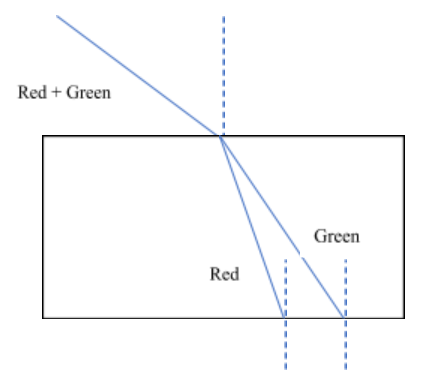
A beam of light composed of red and green rays is incident obliquely at a point on the face of a rectangular glass slab. When coming out on the opposite parallel face, the red and green ray emerge from
A) Two points propagating in two different parallel directions
B) One point propagating in two different directions through slab
C) One point propagating in the same direction through the slab
D) Two points propagating in two different non-parallel directions
Answer
216k+ views
Hint: A beam of light composed of red and green ray when incidents on the glass slab forms an angle with the normal called incidence angle. Then, while passing through the rectangular glass slab gets separated into two rays. Both the rays move at different angles with the normal and thus have different angles of refraction.
Complete answer:

Different colors have different velocities. Thus, the velocity of red is different from the velocity of green. Due to different velocities, in a given medium, red and green refract at different angles of refraction. Thus, due to different angles of refraction they appear on opposite faces at two different points after emerging from the glass slab and move in two different parallel directions.
Hence, the correct answer is option A i.e. two points propagating in two different parallel directions.
Note: The velocity of different colours is the same in vacuum or air. When a light ray travels from one medium to another with different densities or refractive indices, then the ray refracts. However, if the light tray travels in the same medium throughout the journey then instead of refraction the ray gets reflected. There are certain laws related accompanied with reflection. The angle of incidence has to be always equal to the angle of reflection.
Complete answer:

Different colors have different velocities. Thus, the velocity of red is different from the velocity of green. Due to different velocities, in a given medium, red and green refract at different angles of refraction. Thus, due to different angles of refraction they appear on opposite faces at two different points after emerging from the glass slab and move in two different parallel directions.
Hence, the correct answer is option A i.e. two points propagating in two different parallel directions.
Note: The velocity of different colours is the same in vacuum or air. When a light ray travels from one medium to another with different densities or refractive indices, then the ray refracts. However, if the light tray travels in the same medium throughout the journey then instead of refraction the ray gets reflected. There are certain laws related accompanied with reflection. The angle of incidence has to be always equal to the angle of reflection.
Recently Updated Pages
JEE Atomic Structure and Chemical Bonding important Concepts and Tips

JEE Amino Acids and Peptides Important Concepts and Tips for Exam Preparation

Electricity and Magnetism Explained: Key Concepts & Applications

Chemical Properties of Hydrogen - Important Concepts for JEE Exam Preparation

JEE Energetics Important Concepts and Tips for Exam Preparation

JEE Isolation, Preparation and Properties of Non-metals Important Concepts and Tips for Exam Preparation

Trending doubts
JEE Main 2026: Application Form Open, Exam Dates, Syllabus, Eligibility & Question Papers

Derivation of Equation of Trajectory Explained for Students

Hybridisation in Chemistry – Concept, Types & Applications

Understanding the Angle of Deviation in a Prism

Understanding Collisions: Types and Examples for Students

How to Convert a Galvanometer into an Ammeter or Voltmeter

Other Pages
JEE Advanced Marks vs Ranks 2025: Understanding Category-wise Qualifying Marks and Previous Year Cut-offs

Units And Measurements Class 11 Physics Chapter 1 CBSE Notes - 2025-26

NCERT Solutions For Class 11 Physics Chapter 8 Mechanical Properties Of Solids

Motion in a Straight Line Class 11 Physics Chapter 2 CBSE Notes - 2025-26

NCERT Solutions for Class 11 Physics Chapter 7 Gravitation 2025-26

Ideal and Non-Ideal Solutions Explained for Class 12 Chemistry




